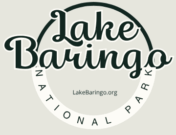Lake Baringo is part of Kenya’s stunning Rift Valley lake system and is renowned for its birdlife. While it is not traditionally famous for large Flamingo populations like Lake Nakuru or Lake Bogoria, Flamingos do visit Lake Baringo—particularly when water chemistry and food availability are favorable.
Lake Baringo acts as an occasional feeding and resting site for both Lesser Flamingos and Greater Flamingos, especially when conditions in nearby alkaline lakes fluctuate.
🧬 Flamingo Species Found at Lake Baringo
1. Lesser Flamingo (Phoeniconaias minor)
- Size: 80–90 cm tall
- Color: Deep pink with black-tipped wings
- Bill: Deep red and black, adapted for filtering microscopic algae
- Feeding: Specializes in cyanobacteria (blue-green algae), particularly Spirulina
2. Greater Flamingo (Phoenicopterus roseus)
- Size: 110–150 cm tall
- Color: Pale pink with light pink legs and bill
- Bill: Light pink with black tip; feeds on small crustaceans, insects, diatoms
- Feeding: More generalized feeder than the Lesser Flamingo
📍 Why Flamingos Visit Lake Baringo
While not a primary breeding ground, Lake Baringo serves as a secondary feeding or resting area, especially when:
- Water levels are stable
- Nearby lakes like Bogoria or Nakuru become too concentrated or flooded
- There is adequate algae growth in parts of the lake
Occasionally, thousands of Flamingos may be seen congregating at Lake Baringo’s southern shores, especially near:
- Kampi ya Samaki
- Robert’s Camp shoreline
- Ol Kokwe Island’s shallow waters
📆 When to See Flamingos at Lake Baringo
| Season | Flamingo Presence | Notes |
|---|---|---|
| Jan – Mar | Occasional sightings | Dry season, fewer disturbances |
| Apr – May (rains) | Unpredictable | Rain may dilute lake, reduce food |
| Jun – Oct | Higher chance | Nearby lakes may be too alkaline |
| Nov – Dec | Good visibility, moderate numbers | Lesser Flamingos begin to return |
Flamingos are highly nomadic, and their movements depend on food supply, alkalinity, and disturbance levels. Their presence in Baringo can vary significantly from year to year.
🪶 Behavior of Flamingos at Lake Baringo
- Feeding: Use their curved bills to filter algae and small invertebrates from shallow water.
- Resting: Often seen standing on one leg, especially in early mornings or late evenings.
- Flocking: Can be seen in flocks of dozens to thousands depending on the season.
- Flight: Flamingos fly in V-formations when moving between Rift Valley lakes.
📸 Best Places to See and Photograph Flamingos at Lake Baringo
- Kampi ya Samaki Bay – Easily accessible shoreline with open water views.
- Boat Rides near Ol Kokwe Island – Good for close-up views when Flamingos are feeding.
- Samatian Island Viewpoints – Elevated views ideal for photographers with zoom lenses.
- Southern Mudflats – Particularly during dry seasons when water recedes.
📷 Tips:
- Visit early morning (6–8 AM) or late afternoon (4–6 PM)
- Use a telephoto lens (300mm+ recommended)
- Avoid getting too close; use a boat or long lens to minimize disturbance
🧭 Relationship with Nearby Flamingo Lakes
Lake Baringo lies close to two of Kenya’s most significant Flamingo habitats:
| Lake | Flamingo Role | Distance from Baringo |
|---|---|---|
| Lake Bogoria | Major feeding ground for Lesser Flamingos; millions congregate during peak years | ~50 km south |
| Lake Nakuru | Historically famous for Flamingos but numbers now fluctuate due to water level changes | ~120 km south |
When food becomes scarce or water chemistry changes at Bogoria or Nakuru, Flamingos often disperse to Baringo, Elementaita, or even further north.
🌿 Threats to Flamingos in the Rift Valley (Including Baringo)
- Pollution: Agricultural runoff, sewage, and plastic waste can contaminate feeding grounds.
- Water Level Fluctuations: Rising or falling levels disrupt feeding and nesting zones.
- Habitat Encroachment: Human settlement, deforestation, and farming near the lake’s edge degrade wetlands.
- Climate Change: Alters rain cycles and salinity across the Rift lakes, impacting algae blooms.
🦺 Conservation Efforts
While Lake Baringo is not a formal Flamingo sanctuary, it’s part of the UNESCO-designated Kenya Lake System World Heritage Site, which recognizes the ecological interdependence of Baringo, Bogoria, and Nakuru.
Ongoing efforts include:
- Community-led ecotourism initiatives
- Birdwatching tourism that creates awareness and alternative incomes
- Conservation monitoring by groups like Nature Kenya, BirdLife International, and local guides
🧳 What to Bring for Flamingo Watching at Lake Baringo
- Binoculars (8×42 or 10×50)
- Camera with telephoto lens (at least 300mm)
- Lightweight clothing and sunhat
- Refillable water bottle
- Notebook or bird checklist
- A guidebook (e.g., Birds of East Africa)
🔚 Final Thoughts: Flamingos in the Rift’s Northern Jewel
Lake Baringo may not have the endless pink shoreline of Lake Bogoria or Nakuru, but it offers rare, peaceful opportunities to see Flamingos in a freshwater environment—a different perspective on their nomadic lifestyle.
If you’re lucky, you might witness a flock of Lesser Flamingos gliding across the lake at dawn, with the escarpments glowing in the golden Rift Valley light. And that is a memory few wildlife experiences can rival.
